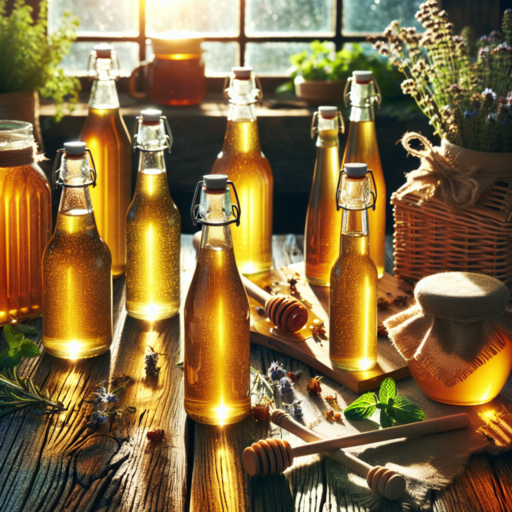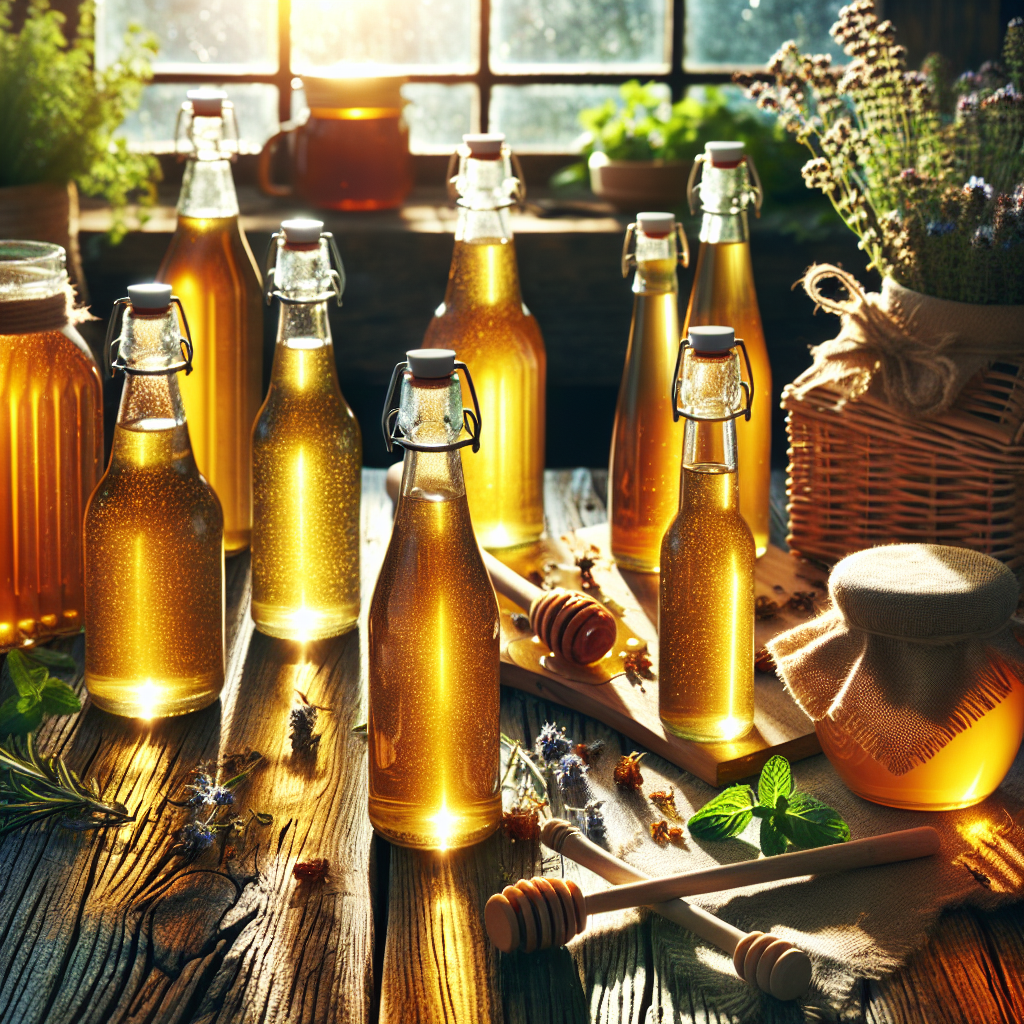The warm scent of cinnamon, the bright zing of mint, or the earthy fragrance of rosemary—these are the moments that elevate mead from a simple honey wine to a liquid masterpiece. Imagine brewing a drink that not only pays homage to tradition but also carries your personal signature, one infused with the flavors of your favorite herbs and spices.
As one of the oldest alcoholic beverages in human history, mead already has a touch of the mythical. But when you embrace the art of metheglins—herb- and spice-infused meads—you step into a realm of creativity that combines history, flavor, and even a little alchemy. These botanicals offer endless possibilities to craft something truly unique, whether you’re after a refreshing summer sipper or a warming winter brew.
This guide will walk you through everything you need to know to start your herbal mead adventure: from the history of metheglins and selecting the perfect botanicals to recipes and practical brewing tips that ensure balance and harmony in every sip. Let’s unlock the magic!
The Origins of Metheglins: Where Herbal Meets Magical
The tradition of infusing herbs into mead is as old as the beverage itself, dating back to ancient cultures that valued both the flavor and medicinal properties of botanicals. The term metheglin originates from the Welsh word “meddyglyn,” meaning “medicinal liquor.” Historically, metheglins weren’t just enjoyed for their taste; they were believed to cure illnesses, soothe the soul, and even offer protection against disease.
Monks in medieval Europe, for example, cultivated herb gardens specifically for brewing. Sage and thyme were included for their antiseptic qualities, while lavender and chamomile were thought to ease stress and promote sleep. These beverages became staples in royal courts and were sometimes assigned near-magical properties based on the herbs they contained.
In the absence of refrigeration, the antimicrobial properties of certain herbs like rosemary and cloves also helped preserve the mead, ensuring a longer shelf life.
Today, metheglins are valued for their depth of flavor, complexity, and the personal touch they bring to brewing. Whether you’re following ancient recipes or forging your own path, the blend of honey, herbs, and imagination is where tradition meets modern-day craftsmanship.
Choosing the Right Herbs and Spices for Your Mead
The success of an herbal mead lies in selecting complementary flavors that enhance both the honey and the overall profile of your drink. Think of the honey as your foundation—the richer, darker honeys like buckwheat or heather will stand up to bold herbs, while lighter honeys like clover or orange blossom benefit from more delicate notes.
Popular Herbs & Their Flavor Profiles:
Rosemary – Piney, resinous, slightly minty – Clover or Wildflower Honey – Savory meads or citrus-infused blends
Mint – Cool, refreshing, lightly sweet – Orange Blossom or Meadowfoam – Summer meads or sparkling varieties
Thyme – Earthy, floral, with a peppery undertone – Buckwheat or Heather Honey – Fruity meads or robust, dark blends
Lavender – Floral, sweet, elegant – Acacia or Star Thistle Honey – Delicate and floral profiles
Cinnamon – Warm, sweet, spicy – Wildflower or Clover Honey – Autumn/winter spiced meads
Cloves – Bold, slightly bitter, and aromatic – Dark honeys like Buckwheat – Mulled meads with apple or pear
Pro Tips for Choosing Herbs:
1. Know Your Honey: Match lighter honeys with delicate herbs (e.g., orange blossom + mint) and darker honeys with strong and bold botanicals (e.g., buckwheat + clove).
2. Start Small: Herbs can be deceivingly potent. Begin with 1–2 grams of dried herbs per gallon (2–4 grams if fresh) and add more gradually.
3. Experiment Freely: Don’t limit yourself to common herbs. Juniper berries, hibiscus, chamomile, or ginger can add exciting twists to your brews!
When to Add Herbs in the Brewing Process
The stage at which you introduce herbs and spices to mead can drastically affect the flavor outcome. Timing is everything in ensuring your botanicals shine without overpowering the drink.
1. Primary Fermentation (The Must)
Adding herbs during this stage integrates their flavors deeply into the mead as fermentation is most active. This works best with bold, robust herbs like rosemary or thyme. However, prolonged contact can sometimes lead to bitterness.
– Best For: Sturdy herbs and woody spices.
– Tip: Place herbs in a muslin bag or cheesecloth to contain particles and make removal easy after fermentation.
2. Secondary Fermentation
Delicate herbs like lavender, mint, or lemon balm thrive here, as this stage is less turbulent. This allows you to preserve fresh or subtle flavors without cooking them off during fermentation.
– Best For: Aromatic and subtle botanicals.
– Tip: Taste-test frequently (every 3–5 days). Oversteeping can turn floral or minty notes bitter.
3. Post-Fermentation (Aging)
Steeping herbs after fermentation gives you full control over flavor intensity. This is ideal for fine-tuning your mead’s profile just before bottling.
– Best For: Spice blends like cinnamon, cloves, or chamomile.
– Tip: Create infusions by steeping herbs in high-proof alcohol first, then adding the tincture drop by drop to find the perfect balance.
Recipes for Herbal-Mead Inspiration
1. Rosemary Lemon Metheglin
Ingredients:
- 3 sprigs fresh rosemary
- Zest of 2 lemons
- 3 lbs wildflower honey
- 1 gallon water
- Lalvin D47 yeast
Instructions:
Add rosemary and lemon zest during secondary fermentation. Let the mead age for 3 months to soften and balance the citrusy-herbal notes.
2. Mint-Lime Sparkling Mead
Ingredients:
- 1 cup fresh mint leaves
- Zest and juice of 2 limes
- 2.5 lbs orange blossom honey
- 1 gallon water
- Champagne yeast
Instructions:
Add mint leaves and lime zest during secondary fermentation. Bottle-condition for 2 weeks to create a light fizz. Chill before serving for a refreshing summer drink.
3. Spiced Winter Metheglin
Ingredients:
- 2 cinnamon sticks
- 3 cloves
- ½ tsp grated nutmeg
- 3 lbs buckwheat honey
- 1 gallon water
- Lalvin K1-V1116 yeast
Instructions:
Add spices in a muslin bag during primary fermentation. Bottle after 6 months for a rich, warming mead with festive notes.
Balancing Flavors: The Alchemy of Perfect Mead
Crafting herbal mead is a delicate balancing act, where too much of one ingredient can overshadow the rest. Follow these guidelines for harmony:
1. Layer in Stages: Add herbs during primary fermentation for depth and during secondary or post-fermentation for brightness or aromatic qualities.
2. Counter Sweetness: Honey’s natural sweetness can be offset by tart fruits (e.g., lemon), bitter herbs (e.g., rosemary), or earthy spices (e.g., cardamom).
3. Taste As You Go: Regular taste testing ensures you don’t over-extract or under-flavor your brew.
Final Thoughts: Create Your Signature Mead
Herbal meads are storytelling in a bottle. Whether you stick to traditional recipes or invent your own, each batch becomes a unique reflection of your creativity.
So, which herbs will you try first? Are you drawn to the bright zest of mint and citrus or the cozy warmth of spice blends? Share your brewing experiments in the comments or tag your creations with #HerbalMeadMagic on social media.
Get ready to bottle a bit of magic—and toast to your flavorful adventure! Cheers!



